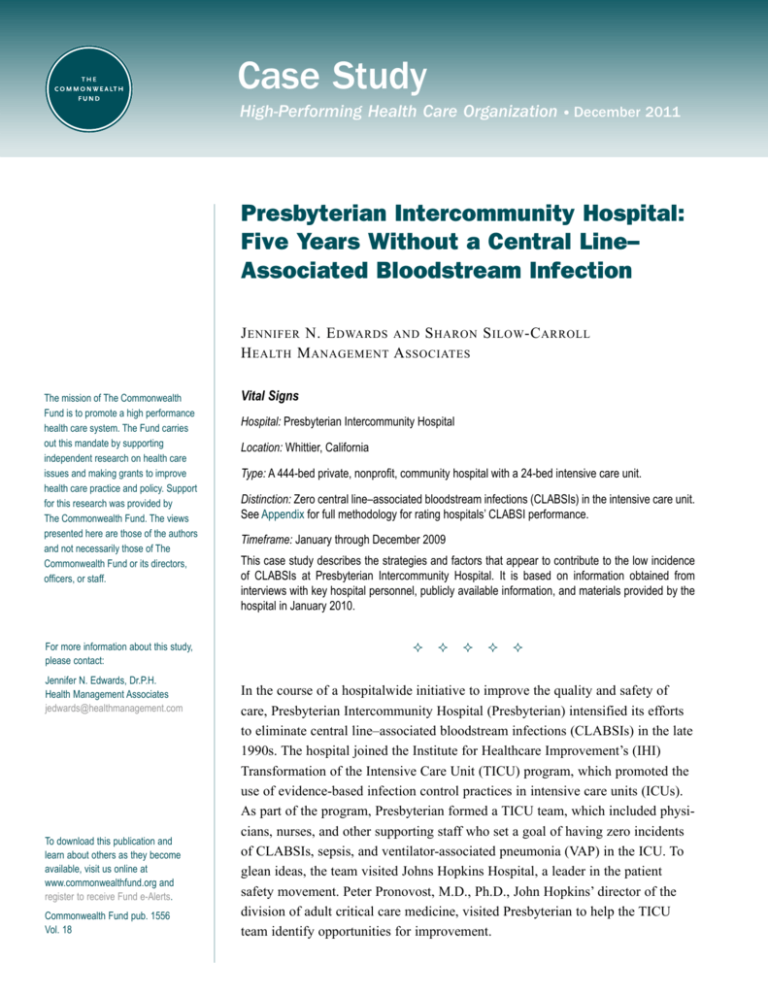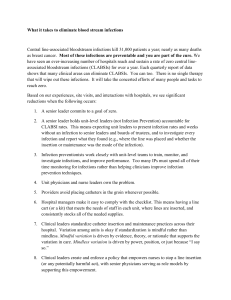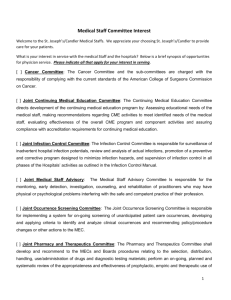Case Study
advertisement

Case Study High-Performing Health Care Organization • December 2011 Presbyterian Intercommunity Hospital: Five Years Without a Central Line– Associated Bloodstream Infection J ennifer N. E dwards and S haron S ilow -C arroll H ealth M anagement A ssociates The mission of The Commonwealth Fund is to promote a high performance health care system. The Fund carries out this mandate by supporting independent research on health care issues and making grants to improve health care practice and policy. Support for this research was provided by The Commonwealth Fund. The views presented here are those of the authors and not necessarily those of The Commonwealth Fund or its directors, officers, or staff. For more information about this study, please contact: Jennifer N. Edwards, Dr.P.H. Health Management Associates jedwards@healthmanagement.com To download this publication and learn about others as they become available, visit us online at www.commonwealthfund.org and register to receive Fund e-Alerts. Commonwealth Fund pub. 1556 Vol. 18 Vital Signs Hospital: Presbyterian Intercommunity Hospital Location: Whittier, California Type: A 444-bed private, nonprofit, community hospital with a 24-bed intensive care unit. Distinction: Zero central line–associated bloodstream infections (CLABSIs) in the intensive care unit. See Appendix for full methodology for rating hospitals’ CLABSI performance. Timeframe: January through December 2009 This case study describes the strategies and factors that appear to contribute to the low incidence of CLABSIs at Presbyterian Intercommunity Hospital. It is based on information obtained from interviews with key hospital personnel, publicly available information, and materials provided by the hospital in January 2010. In the course of a hospitalwide initiative to improve the quality and safety of care, Presbyterian Intercommunity Hospital (Presbyterian) intensified its efforts to eliminate central line–associated bloodstream infections (CLABSIs) in the late 1990s. The hospital joined the Institute for Healthcare Improvement’s (IHI) Transformation of the Intensive Care Unit (TICU) program, which promoted the use of evidence-based infection control practices in intensive care units (ICUs). As part of the program, Presbyterian formed a TICU team, which included physicians, nurses, and other supporting staff who set a goal of having zero incidents of CLABSIs, sepsis, and ventilator-associated pneumonia (VAP) in the ICU. To glean ideas, the team visited Johns Hopkins Hospital, a leader in the patient safety movement. Peter Pronovost, M.D., Ph.D., John Hopkins’ director of the division of adult critical care medicine, visited Presbyterian to help the TICU team identify opportunities for improvement. 2T he C ommonwealth F und Soon after, Presbyterian adopted an evidencebased CLABSI prevention protocol. The central line insertion team began using central line carts—which include drapes, masks, and gloves—to ensure the correct supplies are accessible, as well as checklists to encourage adherence to evidence-based practices. To further standardize the central line insertion process, the hospital relies heavily on intensivists and hospitalists who are present in the hospital at all times and agree to follow care protocols. Nurses are assigned responsibility for monitoring adherence to the protocol, but all staff are encouraged to stop the central line insertion procedure if a lapse in protocol occurs. Per hospital procedure, staff also review daily whether continued use of a central line is necessary. After one week of use, Presbyterian requires staff to move nearly all central lines to peripheral locations. DATA MONITORING AND FEEDBACK The CLABSI prevention checklist becomes a data source for identifying deviations that may contribute to infections. When a deviation in procedure or an infection occurs, a root cause analysis involving clinical and nonclinical staff is performed. The hospital’s infection preventionist conducts an epidemiologic study as well to see if there is a pattern in the type or spread of the bacteria. To address identified problems, the hospital uses the Plan–Do–Check–Act process improvement method. Performance measurement and reporting also play critical roles in the hospital’s infection prevention program. The hospital provides detailed quarterly reports to physician departments on their adherence to the checklist, and infection rates for all CLABSIs are reported quarterly to all physician departments, as well as to the Centers for Disease Control and Prevention’s National Healthcare Safety Network. Through most of its improvement work in the past decade, Presbyterian did not have electronic records that captured quality measures and thus relied on manual processes to track infections and other quality indicators. The hospital’s electronic health record now enables staff to monitor WhyNotTheBest.org CLABSI Series Between 4 percent and 5 percent of hospitalizations result in a health care–associated infection (HAI), at tremendous cost to individuals who become infected and those who fund health care. One of the most common and preventable HAIs is the central line–associated bloodstream infection (CLABSI), which can result when a central venous catheter is not inserted cleanly or maintained properly. An estimated 43,000 CLABSIs occurred in hospitals in 2009 and nearly one of five infected patients died as a result. This case study is part of a series that describes practices used by four leading hospitals that eliminated CLABSIs in their ICUs. The profiled hospitals are extending these strategies to other hospital units and to other HAIs. A synthesis report summarizing lessons from these high-performing institutions is available at http://www.commonwealthfund.org/Publications/ Case-Studies/2011/Dec/CLABSI-synthesis.aspx. Comparative performance data on CLABSIs and other measures of health care quality, safety, outcomes, and patient experience for these four hospitals is available at http://www.whynotthebest. org/reports/view/null/4214. the number of central line days on a hospitalwide basis. In 2008, California passed a law requiring the collection and auditing of data on CLABSIs and the next year the state began publicly reporting hospitalspecific infection rates. In addition to reporting to the state, Presbyterian voluntarily submits infection data to The Leapfrog Group. RESULTS Presbyterian Intercommunity Hospital reduced the number of CLABSIs in its intensive care unit from 4.2 infections per 1,000 central line days in fiscal year 2005 to zero in 2009 (Exhibit 1). At the time of publication, there have been no more recent CLABSIs in the ICU. Presbyterian Intercommunity Hospital: Five Years Without a Central Line–Associated Bloodstream Infection 3 Exhibit 1. Presbyterian Intercommunity Hospital: CLABSIs in the Intensive Care Unit 2004—2011 Infections per 1,000 central line days 4.5 4.2 4.0 3.5 3.0 2.5 2.0 1.4 1.5 1.0 1.5 1.5 0.5 0.0 FY 2004 FY 2005 FY 2006 FY 2007 FY 2008 FY 2009 FY 2010 FY 2011 Source: PIH, March 2011. infection risk. To further support these efforts, staff of the NICU joined the California Perinatal Quality Care Collaborative. Infections in the NICU fell from 6.6 per 1,000 line days in fiscal year 2009 to zero for three consecutive quarters (Exhibit 2). Since then, there have been just two CLABSIs in the NICU. Other hospital units have not been able to calculate rates of central line infections because they do not have a system to track the number of central line days. They do report the actual number of infections, which SPREAD WITHIN THE HOSPITAL In 2008, Presbyterian spread the CLABSI reduction program to the neonatal intensive care unit (NICU) and to medical/surgical floors. A dedicated intravenous therapy nurse was assigned to oversee all lines on the medical/surgical floors and to ensure adherence to policies, including central line duration. A physician champion from the TICU team introduced best practice guidelines to the medical and surgical staff. A team that focuses on peripheral line placement worked to standardize that procedure and raise awareness of Exhibit 2. Presbyterian Intercommunity Hospital: CLABSIs in the Neonatal Intensive Care Unit 2008—2011 Infections per 1,000 central line days 7 6.6 6 5 4 1/345 1/39 3 2.8 2.9 2.5 2 1 0 FY 2008 Source: PIH, March 2011. FY 2009 FY 2010 FY 2011 4T he C ommonwealth F und were seven in fiscal year 2007, three in fiscal year 2008, and one in fiscal 2009. WORK ON OTHER HEALTH CARE– ASSOCIATED INFECTIONS Presbyterian has used similar strategies to reduce the incidence of ventilator-associated pneumonia and catheter-associated urinary tract infections (CAUTIs). To prevent VAP, the staff rely on IHI’s ventilator bundle, a series of interventions related to ventilator care that when implemented together reduce the risk of infection. To reduce CAUTIs, the hospital adopted the recommendations of the Joint Commission’s Core Measure program, which calls for removing the Foley catheter by postoperative day two. Two cases of VAP occurred in the ICU between 2008 and 2011. The ICU had gone three years without a case of VAP, despite the higher level of risk introduced by the H1N1 virus. Four VAP cases occurred in the NICU during the same period, while the number of ventilator days has risen. The hospital has reduced its rate of CAUTIs, but not as rapidly as it has that of CLABSIs and VAP. The rate of CAUTIs in the transitional care unit has fluctuated from 8.4 per 1,000 catheter days in 2008 to 6.1 per 1,000 catheter days in late 2011. LESSONS Presbyterian Intercommunity Hospital’s success at eliminating CLABSIs in its ICU suggests several important lessons for other hospitals, including the importance of having a full-time, committed, intensivist-led team to implement evidence-based guidelines and protocols. Supported by hospital leadership as well as data monitoring and feedback, such teams foster standardization, which is critical to reducing CLABSIs. The teams also play an important role in spreading infection prevention techniques to other units in the hospital. Sending physician and nurse champions to regional or national learning collaboratives helps to nurture the leadership skills necessary to serve in those roles. The hospital also found that engaging frontline staff led to improved outcomes. Presbyterian communicated plans for CLABSI reduction to staff using data and benchmarks to demonstrate room for improvement. According to hospital leaders, the staff’s response was to embrace the changes and adhere closely to the new care standards. Presbyterian physicians were particularly responsive to the hospital’s CLABSI reduction initiative, partly because they saw their performance compared with their peers and wanted to know how they could contribute to better outcomes. FOR FURTHER INFORMATION For further information, contact Judy Pugach, M.P.H., R.N., vice president of quality and risk management, at jpugach@pih.net. Presbyterian Intercommunity Hospital: Five Years Without a Central Line–Associated Bloodstream Infection 5 Appendix. Purpose and Methodology for CLABSI Case Study Series To better understand how some hospitals have succeeded in eliminating CLABSI in their ICUs, The Commonwealth Fund supported Health Management Associates in conducting an analysis of high-performing hospitals. The authors examined: • how CLABSI prevention techniques were implemented and sustained; • whether and how CLABSI prevention practices were extended beyond the ICU to other units and hospital floors; • whether the infection prevention framework was extended to other health care–associated infections; • what challenges hospitals faced in implementing and/or extending infection control interventions; and • what organizational and cultural factors supported the successful adoption and continuation of best infection control practices. To select the hospitals for study, the authors reviewed data made available to The Commonwealth Fund by a special arrangement with Consumer Reports Health, which integrated data from 15 states that require hospitals to report CLABSIs, and the Leapfrog Group, which collects infection data voluntarily reported by hospitals in 45 states. In all, the authors examined data from some 964 hospitals. These hospital-specific data are available on The Commonwealth Fund’s WhyNotTheBest.org Web site. The authors selected four hospitals from approximately 100 with zero CLABSIs and a standardized infection ratio of zero in calendar year 2009. The standardized infection ratio (SIR) represents total reported infections divided by total predicted infections. For CLABSI data, a SIR of 1.0 indicates that a hospital is performing just as would be predicted from national rates. A SIR greater than 1.0 indicates the hospital had more infections than predicted from national rates, and a SIR of less than 1.0 indicates it had fewer infections than predicted. Individual hospitals tend to report CLABSI rates (i.e., number of infections per 1,000 central line days), rather than SIRs. The final selection was based on preferences for: hospitals with the highest number of central line days (indicating more opportunities for infections); those that are not well below average in mortality or readmission rates; and those with scores around the national average or better on measures of patient experiences and adherence to recommended care processes for pneumonia, heart attack, heart failure, and surgery as reported on WhyNotTheBest.org. The selected hospitals also reflect a diversity of facilities, in terms of size and type of operating environment. The authors gathered information through semistructured interviews (by telephone and through site visits) with key hospital leaders and staff knowledgeable about the hospital’s infection control methods and history, and through reviews of hospital data, reports, and other materials made available by the hospital or obtained through Internet searches. This methodology has some limitations. First, it is based on self-reporting, with a mix of unaudited and audited data. There is variation in self-reported CLABSI data, which means the findings may overreport success. Second, other unmeasured factors may affect CLABSI rates. Third, the sample is small and it is inadvisable to generalize to all hospitals based on such a small sample, or assume that hospitals in different circumstances have the capacity to adopt similar strategies. However, by synthesizing findings across the four hospitals and identifying common themes, challenges, innovations, and lessons, the authors offer other hospitals insights and options for reducing health care–associated infections. 6T he C ommonwealth F und A bout the A uthors Jennifer N. Edwards, Dr.P.H., M.H.S., is a managing principal with Health Management Associates’ New York City office. She has worked for 20 years as a researcher and policy analyst at the state and national levels to design, evaluate, and improve health care coverage programs for vulnerable populations. She worked for four years as senior program officer at The Commonwealth Fund, directing the State Innovations program and the Health in New York City program. Dr. Edwards has also worked in quality and patient safety at Memorial SloanKettering Cancer Center, where she was instrumental in launching the hospital’s patient safety program. She earned a doctor of public health degree at the University of Michigan and a master of health science degree at Johns Hopkins University. Sharon Silow-Carroll, M.B.A., M.S.W., is a managing principal at Health Management Associates. She has more than 20 years of experience conducting research and analysis of local, state, and national health system reforms; strategies by hospitals to improve quality and patient-centered care; public–private partnerships to improve the performance of the health care system; and efforts to meet the needs of underserved populations. Prior to joining Health Management Associates, she was senior vice president at the Economic and Social Research Institute, where she directed and conducted policy analysis and authored reports and articles on a range of health care issues. Ms. Silow-Carroll earned a master of business administration degree at the Wharton School and a master of social work degree at the University of Pennsylvania. A cknowledgments The authors would like to thank Judy Pugach, M.P.H., R.N., vice president of quality and risk management; and Helen Litvak, R.N., M.S.N., CIC infection preventionist, for their assistance in providing information for this study. Editorial support was provided by Sarah Klein. Health Management Associates (HMA) is an independent health care research and consulting firm. In May 2010, HMA established a division, HMA Investment Services, to provide generalized information, analysis, and business consultation services to its clients, which principally include investment professionals. Neither HMA nor HMA Investment Services is a registered broker-dealer or investment adviser firm. Research and analysis prepared by HMA on behalf of The Commonwealth Fund is independent of and not influenced by personnel or clients of HMA Investment Services. In particular, the selection of subjects and content for HMA case studies published by The Commonwealth Fund is based solely on objective criteria and is in no way influenced by HMA Investment Services. This study was based on publicly available information and self-reported data provided by the case study institution(s). The Commonwealth Fund is not an accreditor of health care organizations or systems, and the inclusion of an institution in the Fund’s case studies series is not an endorsement by the Fund for receipt of health care from the institution. The aim of Commonwealth Fund–sponsored case studies of this type is to identify institutions that have achieved results indicating high performance in a particular area of interest, have undertaken innovations designed to reach higher performance, or exemplify attributes that can foster high performance. The studies are intended to enable other institutions to draw lessons from the studied institutions’ experience that will be helpful in their own efforts to become high performers. It is important to note, however, that even the best-performing organizations may fall short in some areas; doing well in one dimension of quality does not necessarily mean that the same level of quality will be achieved in other dimensions. Similarly, performance may vary from one year to the next. Thus, it is critical to adopt systematic approaches for improving quality and preventing harm to patients and staff.





